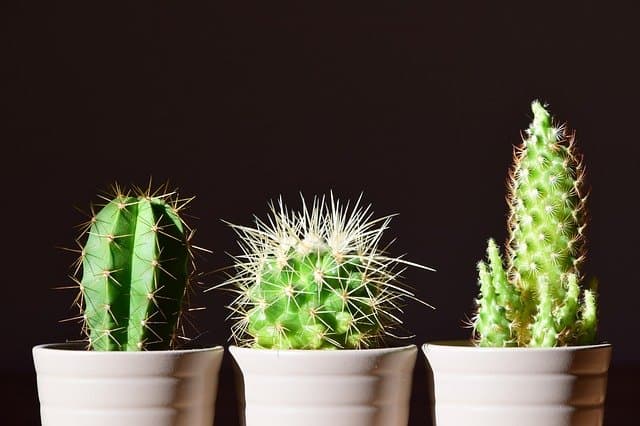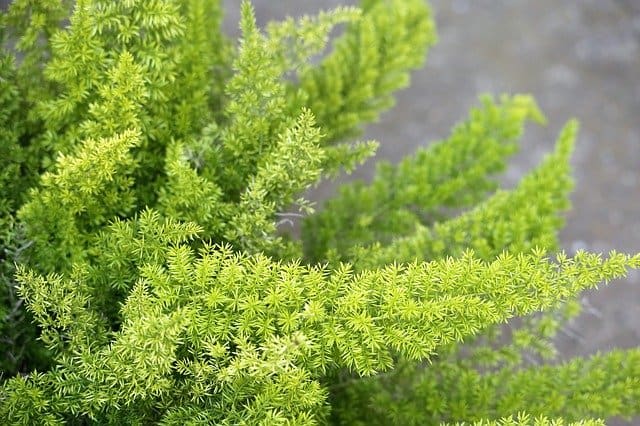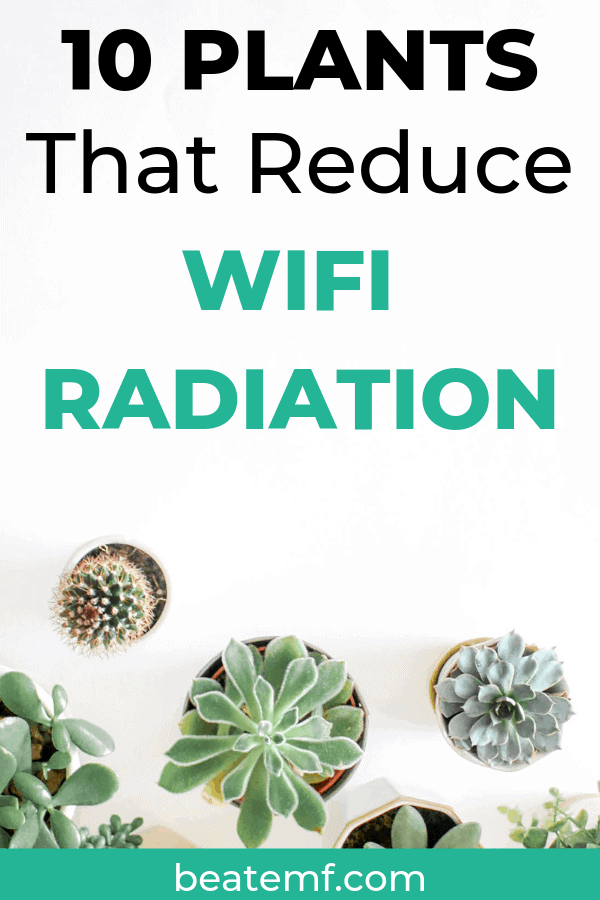We ♥︎ honesty! Beat EMF may earn a commission through links on this page at no additional cost to you.
Got a green thumb and wondering how you can put it to use to detox your home?
Or maybe you heard about the NASA study that proved plants can absorb radiation.
Either way, we want to shed some light on the subject today.
Did you know? I have a FREE mini-course that can help you lower your EMF exposure by 75% in just 7 days!
.(For those of you wanting more comprehensive protection for your home, you need to look into home EMF filters.)
So first, let’s answer the question everyone’s been asking.
Can Plants Really Absorb Radiation?
Yes, but there’s a caveat.
While there’s no such thing as an “anti-radiation plant”…
Studies have shown that certain plants can actively absorb radiation from the environment. Now, we’re not talking nuclear fallout here (though sunflowers did come in handy at Chernobyl), but more so the EMFs we come in contact with every day.
To reduce the harmful effects of electromagnetic radiation, more and more people are picking plants that pull double duty – providing stylish organic decor and a natural air purifier.
But it’s important to understand a plant’s role in an overall strategy for EMF protection.
Plants are not scavengers, meaning they don’t go out seeking radiation and then dispose of it. In other words, plants don’t attract radiation. They simply help mitigate it in a small way via absorption.
Even if plants aren’t the almighty EMF defenders we wished they would be, they can still play a small role in creating a healthy safe haven in our homes.
Besides, they’re pretty, so there’s that 🙂
Now on to what you really came here for – the top 10 plants that absorb EMF and purify the air!
10 Plants That Absorb EMF Radiation
1. Succulents/Cacti

Have you ever seen those plants with fleshy leaves and stems and often very spiky? They’re probably a member of the cacti species.
Its name, cactus, is actually derived from a Greek word meaning spiny or spiky. As scary as the spikes may be to someone who only has a mental image of this plant, cacti are one of the best plants that can protect against EMF radiation.
In 2005, NASA conducted a home-based study and found that at least five plants commonly planted in-house at home or in offices can significantly absorb EMF radiation from electronic devices such as computers and phones – and cactus was one of them.
Cactus can protect you from a variety of radioactive activity. And bonus points for those of us who DON’T have a green thumb:
They are easy to grow and maintain.
It is a plant that naturally thrives in arid areas, so you don’t have to water and monitor it constantly.
Tips for Growing Cactus
You can either grow cactus from seed or from a cutting off of the mother plant. Here is how to do it:
- Take a significant cutting from a healthy mother plant.
- Select a pot where you will plant your cactus.
- Fill the pot with cactus-friendly soil – such as the soil found in arid areas.
- Plant the piece of cactus you cut in the middle of the pot about 2 inches deep.
- Only mist the soil slightly. Don’t over flood it with water.
- Put your planted cutting in a bright location.
- For maintenance: Water your cactus at most twice a month. Don’t over water.
2. Sansevieria (Snake Plant)
Studies on sansevieria have shown that this plant can actively absorb over a hundred different types of poisons.
Being a potent anti-pollutant, studies have also shown this plant to be helpful as an antidote for exposure to certain forms of radiation, including EMF.
Sansevieria is a plant native to West Africa that goes by several other names such as “snake plant” or “mother-in-law’s tongue.” As far as care goes, it’s a hardy plant that’s easy to grow indoors.
Tips for Growing a Snake Plant
There are a few factors you need to consider before you decide to grow a snake plant. For instance:
- Lighting: Indoor plants are best grown under bright light despite the fact that they are tolerant to light and can thrive in dark areas.
- Water: Indoor plants such as sansevieria have acclimatized to growing in somewhat dry conditions – aka they don’t require much watering.
- Temperature: Snake plants thrive well in the temperature range favorable for humans – somewhere between 50 and 80 degrees Fahrenheit.
- Soil type: Fast draining soil is best.
Sansevieria is grown from rhizomes. Here’s how to do it:
- Cut the rhizomes that are close to the leaves of the plant.
- Leave the cut part for a few days so that the cut surface can heal.
- Bury the rhizome that has healed in potting soil inside a pot of your choice.
- Cover with soil around the base – just the crown of the plant, not the leaves.
3. Spider Plant
The spider plant is a common type of succulent. Studies have shown that spider plants are capable of absorbing a variety of pollutants, including harmful gases such as aldehyde and formic acid.
Its impressive abilities in absorbing pollutants qualify it as an effective absorber of EMF radiation as well.
Tips for Growing Spider Plant
Spider plants are hardy plant and will grow even in the harshest of conditions. In perfect conditions, they blossom with stunning leaves that make them the perfect choice for an indoor plant that doubles as decor.
Here is how to grow them:
- These are by far one of the easiest houseplants to plant and propagate. You only need to get a plantlet which has formed roots already.
- Plant the plantlets in a different pot and you are set.
- You can also divide the main plant and re-pot the divided portion.
4. Betel Leaf Plant
Betel leaf plant is among the most trusted absorbers of EMF because there are studies that actually support this claim. It works by preventing radiation-induced damage to DNA – a study that was conducted by researchers in India.
Tips for Growing Betel Leaf Plant
The best way to get started is to simply buy a betel leaf plant from a nursery and continue growing it in your home or office.
However, you can also propagate the plant from the main plant:
- Make about an 18 cm long cutting from the main plant.
- Using a knife, make cuttings just below the leaf node.
- Remove any leaves present (except for the two uppermost leaves, which you can leave as is) as they will hamper the growth process.
- Put the cuttings in a glass and fill with water.
- Allow the cuttings to stand for about a week as you change the water in the glass every two days.
- Place the glass in direct sunlight.
- Once several roots appear, transfer the cuttings to a pot and plant them.
5. Stone Lotus Flower
Most people prefer the stone lotus flower indoors because it is the perfect shape and size for your desk, which is usually an EMF hot spot thanks to computers, wireless printers, and other devices.
Besides being a beautiful plant, the stone lotus flower has potent air purification abilities. It is also believed to be effective in absorbing toxins such as EMF radiation.
It’s even popular as an essential oil thanks to its many health benefits.
Tips for Growing Stone Lotus Flower
Stone lotus can be grown either from the seed or from a tuber. To grow from seed:
- Scrape the seed to remove the husks.
- Put the seeds in warm water and change the water daily. Seeds that float should be removed.
- The seedlings will start growing inside the water.
- Once they are about 6 inches tall, remove them from the water and plant them in a pot.
To grow from tubers:
- Purchase lotus tubers.
- Put them in a bowl of water.
- Change the water constantly every other day until roots start developing.
- Take a container and fill it with soil.
- Transfer the tubers to the pot and water 2-3 times a week.
6. Asparagus Fern

Besides the lovely fragrance this plant can add to your house, it also has potent radiation-absorbing qualities, which makes it a useful plant for EMF heavy areas.
Its antioxidant properties have also proven helpful in the management of people exposed to gamma radiation.
Tips for Growing Asparagus Fern
Asparagus fern has spurs that are somewhat thorny. You might want to wear gloves while working with this plant.
- You can grow asparagus from cuttings or from seed.
- The plant usually thrives well in shade though it will adapt to light.
- Use a well draining potting soil to plant your asparagus fern.
- Asparagus fern requires a significant amount of water. Ensure that you water it adequately – at least once a day.
7. Areca Palm
Areca palm is a popular houseplant for both its aesthetics and well known ability to purify the air of toxins.
It’s especially common (and useful) in homes located in dry areas because it gives off large amounts of water vapor – important for cooling the environment.
It is also a potent absorber of EMF radiation, especially when placed in direct line – without obstruction – with the EMF-emitting device.
For this reason, the areca palm is most useful in home offices or for sprinkling throughout the house, placing in front of outlets.
Tips for Growing Areca Palm
It is easy to grow areca palm indoors, though it is not as hardy as some other radiation reducing plants we’ve mentioned.
- Purchase a small tabletop areca palm plant (bigger is fine – they just get expensive).
- Water it well and routinely, and apply fertilizer to keep it healthy.
- Areca palm thrives with regular pruning, so keep that in mind.
- Ensure that you change the potting at least once a year.
8. Rubber Plant
The rubber plant is an easier plant to keep and maintain. It is relatively small in size and with a faster growth rate – appropriate for indoor planting, though others may prefer planting it outdoors.
Tips for Growing Rubber Plant
You can start growing a rubber plant from stem cuts or from seeds:
- Obtain a stem cut from a mature plant
- Plant the stem in a rooting medium, preferably, a pot.
Alternatively:
- You can start the plant from a seed by planting the seed in a small tray.
- Once the seedling achieves a significant height and with enough roots, transfer it to a larger growing pot
9. Aloe Vera
Besides its highly effective medicinal value, Aloe Vera is one of the best plants that absorb radiation and EMF emissions.
Just like other plants, it can also help clean and purify the air in your room by actively absorbing carbon dioxide while giving out oxygen simultaneously.
It is easy to grow and pleasant to look at – a charming combination that makes it a clear houseplant winner.
Tips for Growing Aloe Vera
New Aloe Vera plants will bud continuously from the main plant.
As a result, you can just pick the new plants and plant them in a pot or a container of your choice.
- Be careful about the amount of water you add to the plant. Excess water causes root rot and withering leaves.
- The ideal soil type is reminiscent to the fast draining soil for planting other succulents such as cactus.
- To make your plant do best, keep it under light but away from direct sunlight.
- For it to work effectively in absorbing radiation, place the plant directly in line with any devices that emit EMF.
10. Sunflower
Tens of thousands to millions of sunflowers have been planted in radioactive areas to help absorb radioactive emissions. As such, sunflowers have proven to be one of the most effective, natural absorbers of radiation.
In fact, sunflowers plants were planted around the Chernobyl site to help clear the radioactive cesium from the environment.
Tips for Growing Sunflower
Sunflower is mostly an outdoor plant, though some people may occasionally plant it indoors. It is usually grown from seeds.
- Space the seeds in shallow trenches with sandy soils. The spacing should be about 6 inches apart in depths of up to 2 inches.
- Cover the seeds and water them. They will sprout in 7 to 10 days.
- Thin the plants to about 2 feet apart once they have grown their second set of leaves.
- The plants usually yield seeds within 80 to 120 days after planting.
Frequently Asked Questions
Do cacti absorb radiation?
Cacti is best known for absorbing radiation around computers. Most theories attribute its anti radiation plant abilities to the cacti’s high water content. Though helpful, a single cactus alone is not enough to mitigate computer radiation. Distance is the best, most effective solution.
Do sunflowers absorb radiation?
Yes! In fact, sunflowers were the chosen vessel by researchers to plant around the Chernobyl site. They were effective in extracting cesium from surrounding ponds.
How do plants remove toxins?
Plants act as filters. We already know they take surrounding carbon dioxide and convert it into clean, breathable oxygen. There are some theories that plants also work to retain or filter radiation, leaving cleaner air around it. Live plants have been shown to effectively filter carbon monoxide, formaldehyde, and other toxins from the air.
How many plants does it take to purify the air in a room?
The 1989 NASA study suggests a range of 15 to 18 plants is enough to purify the air in an 1,800 square foot building. They also suggest each plant be planted in a container roughly 6 to 8 inches in diameter.
Side Note: I just want to quickly address the times we’re living in. Many people are feeling hopeless, depressed, confused, isolated…just overwhelmed. Can you relate? If you need a dose of hope right now, please click here to read my personal note to you.
Certified EMF Expert, Chief Editor & Researcher at Beat EMF. I’m in charge of testing all the products and sorting through the duds to deliver effective EMF solutions for your family. Learn more about me here.





When you’re addressing electromagnetic radiation, what wavelengths on the scale are you addressing?
I’d like to read the paper from NASA on plants absorbing radiation if you have it.
Hi Erin,
The paper is titled “Interior Landscape Plants for Indoor Air Pollution Abatement. Final Report” published September 15, 1989. When I tried to link to it here, I received an error message. However, here is an NCBI report that discusses it as well – https://www.ncbi.nlm.nih.gov/pmc/articles/PMC3230460/#r4
As for wavelengths, I’m primarily concerned with shielding against radio waves and microwaves. Plants are not enough to shield sufficiently, of course, but it’s just a small tool we can use as part of an overall protection/reduction strategy.
If this plants absorb this radiations, will they have harmful effects? Will they have any damages?
Nope 🙂
Sanduni, I am not sure what the specific plants in this list will do with EMFs, but a number of other plants that have absorbed EMFs do not fare so well.
In one case, it is thought that what we once thought was acid rain damage in temperate pine forests (back in the 1970s/80s) seems to have instead been radiation damage from cold war radar installations. Researchers have opined that the pine needles acted as antennas to bring those microwaves into the plant, causing various changes to metabolism, leading to higher production of Hydrogen ions released by the roots, hence the unexpected acidification of the soil. These forests seem to have recovered in the 1990s, coincident with the end of the cold war and dismantling of those large radar installations (Northern Europe and and North America). These are mentioned in Arthur Firstenberg’s book.
A second experiment, first done by science-minded schoolchildren in Europe demonstrated that germination and early growth is adversely affected by Wifi router. This was reproduced by Havas and Symmington in 2016 under the title “Effects of Wi-Fi Radiation on Germination and Growth of Broccoli, Pea, Red Clover and Garden Cress Seedlings: A Partial Replication Study”
Hi, this article and the report you cite discuss air pollution, not radiation. Can you share the report for plants absorbing radiation?
I agree with you, I would love to read the whole article
I’m really concerned about my fridge emitting too many emfs. I felt a difference the second I plugged it in. I can feel a pressure on my chest and dizziness. Any tips on how to ground these frequencies? I am in an apartment building in the middle of the building with no access to grounded outlets.
Ana, the most common EMF from a refrigerator will come when the compressor motor is actively running. This creates a high magnetic field for at least a few feet in all directions, especially behind it. Magnetic fields are not blocked by walls so having a couch or bed near the back side of a fridge is disrecommended.
All devices have Electric fields from their power cords. These fields emanate 4-8 feet in all directions, but unless you are sensitive you might not be aware of these. The one exception is if there is a lot of harmonics on your electric system, in which a person might have the symptoms you describe. You can tell whether it was the fridge OR that particular outlet by plugging in another device (such as a hair dryer running on a low setting) and seeing whether you have similar symptoms.
Some fridges will generate harmonics on their own, either because some part of them is failing (ie, arcing, causing broad spectrum noise on the wiring) or because they have some sophisticated electronics inside, as these create DE. Some of the most modern refrigerators integrate with WIFI or other home networks and this kind of RF radiation can really affect sensitive people, with symptoms like you describe.
Finally, if your refrigerator has a water line connected (for cold water or ice-making) then this could be a completely different source of magnetic fields due to unhindered current flowing on the metal pipes, though generally this is only possible if your municipal water supply is completely metal all the way out to the street. In many places, dielectric unions or 10 ft long pieces of plastic piping have been added to break the electrical conductivity and eliminate the spurious current flow.
Where would you place your WiFi router in your home? We started homeschooling last year and I feel like my kids are always near it. We have it in our downstairs closet which is centrally located. We have this supposed emf protecting cloth around it but I’m not so sure about it. We also have snake plants in the main areas the kids play in. The WiFi router (if that’s what it’s called) used to be in our extra room but that became a nursery. I just hate how wherever my kids play it doesn’t seem far enough away from the WiFi. We turn the WiFi off at night. I’d love to get rid of WiFi but we aren’t able to yet. Do you think putting it in our master bedroom is a bad idea? We spend the least about of time there and it seems to be the farthest away spot from my kids. I’m not sure what is considered a safe distance. It would be easier not to have to move it again of course.
I guess I don’t get the point of this article. You would have to create a wall of ” shield plants” between yourself and the source. There are better materials than plants for that purpose. EMF doesn’t float around as a particle that you breathe though it could react with air chemistry and change it. The energy level to do that would have to be very high such as in the conversion of O2 to O3. Please enlighten me as to how these plants deal with the harmful effects of EMF. Do you eat them and they dispose of free radicals that may have been created by exposure to EMF wave forms?